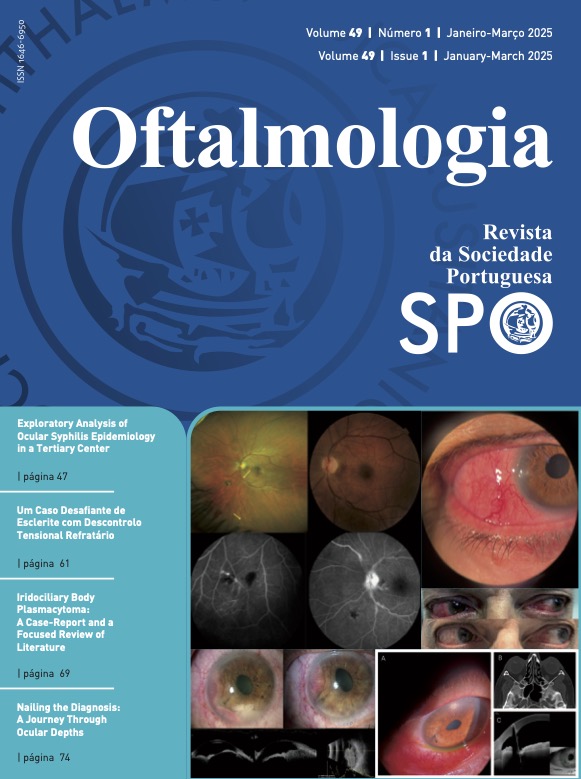Ectasia Pós Cirurgia Refrativa Laser: O Papel da Biomecânica Corneana
DOI:
https://doi.org/10.48560/rspo.33198Palavras-chave:
Cirurgia Laser da Córnea/efeitos adversos, Doenças da Córnea/cirurgia, Laser In-Situ Keratomileusis/efeitos adversos, Queratectomia Fotorrefrativa/efeitos adversosResumo
INTRODUÇÃO: A ectasia corneana pós cirurgia refrativa laser (LVC) pode ameaçar a visão. Analisamos os dados pré-operatórios clínicos, tomográficos e biomecânicos de doentes submetidos a queratectomia fotorrefrativa (PRK) e laser in-situ keratomileusis assistido por laser femtosegundo (FS-LASIK) para correção de miopia e/ou astigmatismo, com o objetivo de avaliar o seu risco ectásico pré- e pós-operatório.MÉTODOS: Estudo retrospetivo com doentes submetidos a FS-LASIK e PRK, entre Novembro de 2020 e Setembro de 2021. que completaram pelo menos 6 meses de seguimento. A tomografia corneana foi avaliada através do Pentacam HR (Oculus) e a biomecânica com o Corvis ST (Oculus). O risco ectásico pré-operatório foi também avaliado pela percentagem de tecido alterado (PTA) e uma ferramenta de inteligência artificial (Brain Cornea). Aos 6 e 24 meses avaliamos o CBI-LVC, bem como os resultados refrativos e tomográficos.
RESULTADOS: Foram incluídos 268 olhos de 139 doentes (grupo 1 - FS-LASIK: 186; grupo 2 - PRK: 82) e 210 (FS-LASIK: 142; PRK: 68) completaram o seguimento. Aos 24 meses, 3 olhos apresentaram CBI-LVC>0,2 (PRK=2; FS-LASIK=1). Não foram identificados casos de ectasia corneana clinicamente relevante. No grupo do FS-LASIK o K1 e K2 aumentaram de forma estatisticamente significativa entre os 6 e 24 meses, com uma correlação positiva com o TBI pré-operatório (r(140)=0,263; p=0,008).
CONCLUSÃO: Um número residual de olhos apresentou um CBI-LVC indicativo de ectasia pós-LVC. A avaliação pré-operatória foi eficaz, tanto em termos de segurança como de estabilidade pós-operatória. A regressão refrativa observada em olhos submetidos a FS-LASIK parece ser tanto maior quanto maior o risco ectático pré-operatório. A biomecânica pré-operatória pode influenciar a regressão refrativa após o FS-LASIK.
Downloads
Referências
Geggel HS. Delayed onset keratectasia following laser in situ keratomileusis. J Cataract Refract Surg. 1999;25:582-6. doi: 10.1016/s0886-3350(99)80060-1.
Rao SN, Epstein RJ. Early onset ectasia following laser in situ keratomileusus: Case report and literature review. J Refract Surg. 2002;18:177-84. doi: 10.3928/1081-597X-20020301-13.
Lifshitz T, Levy J, Klemperer I, Levinger S. Late bilateral keratectasia after LASIK in a low myopic patient. J Refract Surg. 2005;21:494-6. doi: 10.3928/1081-597X-20050901-12.
Seiler T, Koufala K, Richter G. Iatrogenic keratectasia after laser in situ keratomileusis. J Refract Surg. 1998;14:312-7. doi: 10.3928/1081-597X-19980501-15.
Esporcatte LPG, Salomão MQ, Neto AB da C, Machado AP, Lopes BT, Ambrósio R. Enhanced Diagnostics for Corneal Ectatic Diseases: The Whats, the Whys, and the Hows. Diagnostics. 2022;12:3027. doi: 10.3390/diagnostics12123027.
Belin MW, Ambrósio R. Enhanced Screening for Ectasia Risk prior to Laser Vision Correction. Diagnostics. 2022;12:3027. doi: 10.3390/diagnostics12123027.
Dupps WJ Jr, Wilson SE. Biomechanics and wound healing in the cornea. Exp Eye Res. 2006;83:709-20. doi: 10.1016/j.exer.2006.03.015.
Randleman JB, Woodward M, Lynn MJ, Stulting RD. Risk assessment for ectasia after corneal refractive surgery. Ophthalmology. 2008;115:37-50. doi: 10.1016/j.ophtha.2007.03.073.
Ambrósio R, Dawson DG, Salomão M, Guerra FP, Caiado ALC, Belin MW. Corneal ectasia after LASIK despite low preoperative risk: Tomographic and biomechanical findings in the unoperated, stable, fellow eye. J Refract Surg. 2010;26:906-11. doi: 10.3928/1081597X-20100428-02.
Bühren J, Schäffeler T, Kohnen T. Preoperative topographic characteristics of eyes that developed postoperative LASIK keratectasia. J Refract Surg. 2013;29:540-9. doi: 10.3928/1081597X-20130719-04.
Roberts CJ, Mahmoud AM, Bons JP, Hossain A, Elsheikh A, Vinciguerra R, et al. Introduction of two novel stiffness parameters and interpretation of air puff-induced biomechanical deformation parameters with a dynamic Scheimpflug analyzer. J Refract Surg. 2017;33:266-73. doi: 10.3928/1081597X-20161221-03.
Ambrósio, Jr R, Correia FF, Lopes B, Salomão MQ, Luz A, Dawson DG, et al. Corneal biomechanics in ectatic diseases: refractive surgery implications. Open Ophthalmol J. 2017;11:176-93. doi: 10.2174/1874364101711010176
Vinciguerra R, Ambrósio R, Elsheikh A, Hafezi F, Kang DS, Kermani O, et al. Detection of postlaser vision correction ectasia with a new combined biomechanical index. J Cataract Refract Surg. 2021;47:1314-8. doi: 10.1097/j.jcrs.0000000000000629.
Jin SX, Dackowski E, Chuck RS. Risk factors for postlaser refractive surgery corneal ectasia. Curr Opin Ophthalmol. 2020;31:288-92. doi: 10.1097/ICU.0000000000000662.
Seiler T, Quurke AW. Iatrogenic keratectasia after LASIK in a case of forme fruste keratoconus. J Cataract Refract Surg. 1998;24:1007-9. doi: 10.1016/s0886-3350(98)80057-6.
Bohac M, Koncarevic M, Pasalic A, Biscevic A, Merlak M, Gabric N, et al. Incidence and Clinical Characteristics of Post LASIK Ectasia: A Review of over 30.000 LASIK Cases. Semin Ophthalmol. 2018;33:869-77. doi: 10.1080/08820538.2018.1539183.
Randleman JB. Post-laser in-situ keratomileusis ectasia: Current understanding and future directions. Curr Opin Ophthalmol. 2006;17:406-12. doi: 10.1097/01.icu.0000233963.26628.f0.
Pallikaris IG, Kymionis GD, Astyrakakis NI. Corneal ectasia induced by laser in situ keratomileusis. J Cataract Refract Surg. 2001;27:1796-802. doi: 10.1016/s0886-3350(01)01090-2.
Gil JQ, Lobo C, Tavares C, Costa E, Rosa AM, Quadrado MJ, et al. Guidelines for Excimer Laser Refractive Surgery on Cornea. Oftalmologia. 2015;39:1-16.
Shortt AJ, Allan BDS, Evans JR. Laser-assisted in-situ keratomileusis (LASIK) versus photorefractive keratectomy (PRK) for myopia. Cochrane Database Syst Rev. 2013:CD005135. doi: 10.1002/14651858.CD005135.pub3.
Torricelli AA, Bechara SJ, Wilson SE. Screening of refractive surgery candidates for LASIK and PRK. Cornea. 2014;33:1051-5. doi: 10.1097/ICO.0000000000000171.
Bamashmus M, Saleh MF, Abdulrahman M, Al-Kershy N. Reasons for not performing LASIK in refractive surgery candidates in Yemen. Eur J Ophthalmol. 2010;20:858-64. doi: 10.1177/112067211002000508.
Randleman JB, Russell B, Ward MA, Thompson KP, Stulting RD. Risk factors and prognosis for corneal ectasia after LASIK. Ophthalmology. 2003;110:267-75. doi: 10.1016/S01616420(02)01727-X.
Kymionis GD, Bouzoukis D, Diakonis V, Tsiklis N, Gkenos E, Pallikaris AI, et al. Long-term results of thin corneas after refractive laser surgery. Am J Ophthalmol. 2007;144:181-5. doi: 10.1016/j.ajo.2007.04.010. E
Santhiago MR, Smadja D, Gomes BF, Mello GR, Monteiro ML, Wilson SE, et al. Association between the percent tissue altered and post-laser in situ keratomileusis ectasia in eyes with normal preoperative topography. Am J Ophthalmol. 2014;158:87-95.e1. doi: 10.1016/j.ajo.2014.04.002.
Mohammadpour M. Risk for ectasia with LASIK. J Cataract Refract Surg. 2008;34:181-2; author reply 182-3. doi: 10.1016/j.jcrs.2007.10.019.
Ambrósio R, Caiado ALC, Guerra FP, Louzada R, Roy AS, Luz A, et al. Novel pachymetric parameters based on corneal tomography for diagnosing keratoconus. J Refract Surg. 2011;27:753-8. doi: 10.3928/1081597X-20110721-01.
Ambrósio R, Machado AP, Leão E, Lyra JMG, Salomão MQ, Esporcatte LGP, et al. Optimized artificial intelligence for enhanced ectasia detection using scheimpflug-based corneal tomography and biomechanical Data. Am J Ophthalmol. 2023;251:126-42. doi: 10.1016/j.ajo.2022.12.016.
Baptista PM, Marta AA, Marques JH, Abreu AC, Monteiro S, Menéres P, et al. The role of corneal biomechanics in the assessment of ectasia susceptibility before laser vision correction. Clin Ophthalmol. 2021;15:745-58. doi: 10.2147/OPTH.S296744.
Ambrósio R, Ramos I, Lopes B, Canedo ALC, Correa R, Guerra F, et al. Assessing ectasia susceptibility prior to LASIK: The role of age and residual stromal bed (RSB) in conjunction to Belin-Ambrósio deviation index (BAD-D). Rev Bras Oftalmol. 2014;73:75-80.
Ambrósio R, Lopes BT, Faria-Correia F, Salomão MQ, Bühren J, Roberts CJ, et al. Integration of scheimpflug-based corneal tomography and biomechanical assessments for enhancing ectasia detection. J Refract Surg. 2017;33:434-43. doi: 10.3928/1081597X-20170426-02.
Vieira R, Marta A, Abreu AC, Monteiro S, Do Céu Brochado M. Quality of Vision After LASIK, PRK and FemtoLASIK: An Analysis Using the Double Pass Imaging System HD AnalyzerTM®. Clinical Ophthalmology. 2022;16.
Kim G, Christiansen SM, Moshirfar M. Change in keratometry after myopic laser in situ keratomileusis and photorefractive keratectomy. J Cataract Refract Surg. 2014;40:564-74. doi: 10.1016/j.jcrs.2013.09.016.
Kamiya K, Miyata K, Tokunaga T, Kiuchi T, Hiraoka T, Oshika T. Structural analysis of the cornea using scanning-slit corneal topography in eyes undergoing excimer laser refractive surgery. Cornea. 2004;23:S59-64. doi: 10.1097/01.ico.0000136673.35530.e3.
Miyata K, Tokunaga T, Nakahara M, Ohtani S, Nejima R, Kiuchi T, et al. Residual bed thickness and corneal forward shift after laser in situ keratomileusis. J Cataract Refract Surg. 2004;30:1067-72. doi: 10.1016/j.jcrs.2003.09.046.
Asroui L, Dupps WJ, Randleman JB. Determining the utility of epithelial thickness mapping in refractive surgery evaluations. Am J Ophthalmol. 2022;240:125-34. doi: 10.1016/j.ajo.2022.02.021.
Loukovitis E, Sfakianakis K, Syrmakesi P, Tsotridou E, Orfanidou M, Bakaloudi DR, et al. Genetic aspects of keratoconus: a literature review exploring potential genetic contributions and possible genetic relationships with comorbidities. Ophthalmol Ther. 2018;7:263-92. doi: 10.1007/s40123-018-0144-8.
Downloads
Publicado
Como Citar
Edição
Secção
Licença
Direitos de Autor (c) 2024 Revista Sociedade Portuguesa de Oftalmologia

Este trabalho encontra-se publicado com a Creative Commons Atribuição-NãoComercial 4.0.
Não se esqueça de fazer o download do ficheiro da Declaração de Responsabilidade Autoral e Autorização para Publicação e de Conflito de Interesses
O artigo apenas poderá ser submetido com esse dois documentos.
Para obter o ficheiro da Declaração de Responsabilidade Autoral, clique aqui
Para obter o ficheiro de Conflito de Interesses, clique aqui





